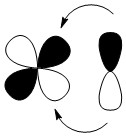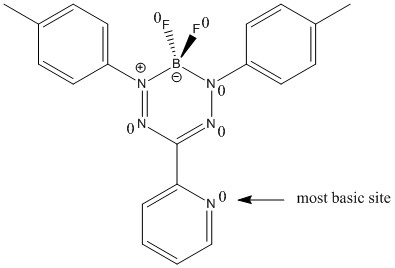Chemistry 401
Intermediate Inorganic Chemistry
University of Rhode Island
Fall 2017
Final Exam
All citations are to Inorg. Chem., 2017, 56
1. R. T. P. Sant’Anna and R. B. Faria (pages 11160 – 11167) investigated the kinetics of the reaction between chlorate and nitrous acid under acidic conditions. Balance the reaction shown below. Use the Latimer diagrams given to estimate the standard potential for the reaction.
ClO3–(aq) + HNO2(aq) → Cl–(aq) + NO3–(aq)
NO3– → +0.803 N2O4 → +1.07 HNO2
ClO3– → +1.468 Cl2 → +1.358 Cl–
Cl is reduced: ClO3–(aq) + 6 H+(aq) + 6 e– → Cl–(aq) + 3 H2O(l) E°red = [(5)(1.468) + (1)(1.358)]/(5 + 1) = +1.450 V
N is oxidized: HNO2(aq) + H2O(l) → NO3–(aq) + 3 H+(aq) + 2 e– E°red = [(1)(0.803) + (1)(1.07)]/(1 + 1) = +0.937 V
Net: ClO3–(aq) + 3 HNO2(aq) → Cl–(aq) + 3 NO3–(aq) + 3 H+(aq) E° = 1.450 – 0.937 = +0.513 V
2. V. Yempally, S. Moncho, F. Hasanayn, W. Y. Fan, E. N. Brothers, and A. A. Bengali (pages 11244 – 11253) examined the photochemistry of Mn(bpy)(CO)3Br. Name each isomer of the compound, estimate the LFSE in terms of Dq and P, predict the stability of the compound using the EAN rule, and predict the distortion of the compound if it is Jahn-Teller active.
There are two isomers:
, which is named fac-2,2'-bipyridinebromotricarbonylmanganese(I) and
, which is named mer-2,2'-bipyridinebromotricarbonylmanganese(I)
Mn(I) is d6 and 5 of the six ligands are strong so the complex will be low spin with LFSE = 24Dq – 2P and is not Jahn-Teller active. In terms of the EAN rule, the Mn contributes 6 e–, each CO contributes 2 e–, the Br– contributes 2 e–, and each N atom in the bpy contributes 2 e–, so the total count is 6 + 3(2) + 2 + 2(2) = 18, so the complex is predicted to be stable.
3. G. Ciancaleoni, L. Belpassi, and F. Marchetti (pages 11266 – 11274) address the debate whether chloride ion can back donate electron density into d orbitals in Nb(V). If this bonding motif can be achieved, which orbital(s) on the Cl– and which orbital(s) on the metal would be involved? Draw a sketch of the atomic orbitals that would be used to form the molecular orbital that would be involved in the back-donation.
A p-orbital on the Cl– could donate electrons into an empty t2g orbital on the Nb. A sketch:

4. Md. M. Rahman, M. D. Smith, J. A. Amaya, T. M. Makris, and D. V. Peryshkov (pages 11798 – 11803) used a Lewis pair, TaCl5-PPh3 (Ph = phenyl), to activate C-H bonds. Identify the Lewis acid, the Lewis base, and draw the structures and give the point group of each component.
Lewis acid: TaCl5:
belonging to the D3h point group.
Lewis base: PPh3:
belonging to the C3v point group.
5. S. M. Barbon, J. V. Buddingh, R. R. Maar, and J. B. Gilroy (pages 12003 – 12011) studied the reactivity of the boron difluoride formazanate shown below. Give the formal charges for each B, F, and N atom. The compound is a Brønsted-Lowry base – which atom would act as the hydrogen-ion acceptor? Explain your reasoning.
The formal charges are shown on the structure:

Owing to the positive charge on the central heterocyclic ring, the electron density on each N in that ring is reduced, making them less basic. Thus, the most basic site is the N atom on the pyridine ring.
6. M. A. Manumpil, C. Leal-Cervantes, M. R. Hudson, C. M. Brown, and H. I. Karunadasa (pages 12682 – 12686) synthesized a prussian blue analogue that contained vanadium species. Upon exposure to humid air the following reaction was observed: VO2+ + O2 → VO2+. Balance the reaction.
Oxidation: VO2+ + H2O → VO2+ + 2 H+ + e–
Reduction: O2 + 4 H+ + 4 e– → 2 H2O
Net: 4 VO2+ + O2 + 2 H2O → 4 VO2+ + 4 H+
7. N. Das, S. Singh, A. G. Joshi, M. Thirumal, V. R. Reddy, L. C. Gupta, and A. K. Ganguli (pages 12712 – 12718) demonstrated that Pr2FeCoO6 has both a magnetic moment and an electric moment. Give the electron configuration of each ion in this compound.
Pr3+: [Xe]4f2
Fe3+: [Ar]3d5
Co3+: [Ar]3d6
O2–: [Ne] or [He]2s22p6
8. M. A. Zykin, K. A. Babeshkin, O. V. Magdysyuk, E. O. Anokhin, W. Schnelle, C. Felser, M. Jansen, and P. E. Kazin (pages 14077 – 14083) doped cobalt into hydroxyapatite to create a magnetic material. Structural studies showed that the cobalt ligated by two oxide ions in an unusual bent geometry, [CoO2]2–. Predict the spin-only magnetic moment for the cobalt in units of Bohr-magnetons (recall: μ = [n(n+2)]½ μB). Explain how you made your decision to determine if the cobalt is in a high spin or low spin state.
Co2+ in [CoO2]2– must be high spin because there are only 2 ligands. This means that the splitting of the d orbitals will be small (similar to the tetrahedral geometry case) and that the pairing energy will always be large compared to the splitting. Thus, there will 3 unpaired spins and the spin-only magnetic moment will be ~[3(3+2)]½ = 3.87 μB.
9. R. K. Hona, A. Huq, and F. Ramezanipour (pages 14494 – 14505) investigated Ca2FeCoO6-δ. For δ = 0, give the likely oxidation state for each atom in the compound. When 0 < δ < 1, the compound is a semiconductor: is this p-type or n-type? Explain your reasoning.
When δ = 0 the compound is Ca2FeCoO6. The oxides bring a total of –12 charge which means that the total positive charge distributed among the metal ions is +12. Calcium only has one oxidation state available, +2, which leaves +8 for the transition metal ions. Finding cobalt or iron in an oxidation of +5 or higher is unlikely so the likely oxidation states for cobalt and iron are +4. To summarize: Ca2+, Fe4+, Co4+, and O2–.
Removing some of the oxide ions when 0 < δ < 1 leaves an excess of positive charge, so the material would be a p-type semiconductor.
10. J.-H. Feng, C.-L. Hu, H.-P. Xia, F. Kong, and J.-G. Mao (pages 14697 – 14705) studied the optical properties of Li7(TeO3)3F. Draw the Lewis structure for the TeO32– anion, predict the molecular structure, and estimate the bond angles to ±2°.
Lewis structure:

Molecular structure:

All O-Te-O bond angles will be slightly smaller than the ideal tetrahedral angle, ~108 - 109°

